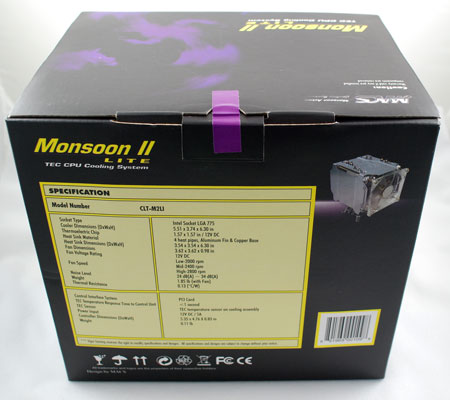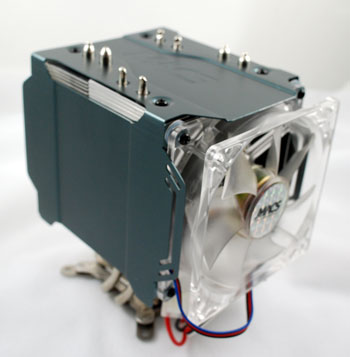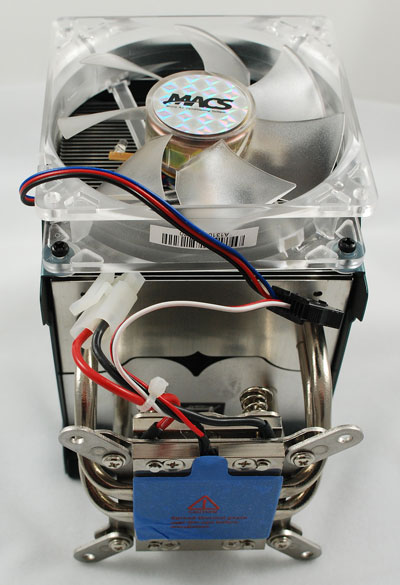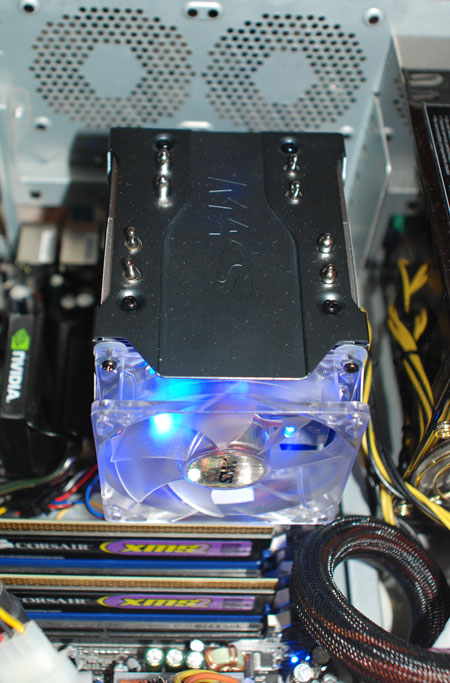Monsoon II Lite: Thermal Electric Cooling Tower
by Wesley Fink on February 6, 2007 6:00 AM EST- Posted in
- Cases/Cooling/PSUs
Monsoon II Lite
When you first look at the Monsoon II package you might assume it is just another of the proliferating heatpipe tower coolers. The package looks about the same as other top HSF tower coolers.


The only clue that something is different here is the description: "TEC CPU Cooling System". The rear of the box also details the specifications.

Inside the box you will find the HSF packed in a clear acrylic clamshell and a white box filled with accessories. The Monsoon II unit is large, but it is actually a bit smaller than most top tower coolers. The HSF is a multi-finned tower design with four heatpipes, similar to other cooling tower designs like the Tuniq Tower 120 and the Scythe Infinity. The finned heatpipe assembly looks a bit different, however, because it is mostly enclosed in a metal shroud to direct airflow from the fan to the back of the unit.

In the white box you will find some of the unique components of this kit. This includes the back plate with four attachment screws already in place, the instruction manual, the PCI card for controlling the TEC cooler, and a bag of connectors and small parts.

The small parts bag contains the four spring-loaded thumb screws for attaching the HSF, a tube of thermal compound, a shielded combination cable that will run from the PCI card to the TEC and fan, a badge for your case, and a 4-pin Molex extender. The Molex cable runs from a standard 4-pin connector from the power supply to the power connection on the PCI card; it is really just an extension cord in case the regular 4-pin Molex won't reach the PCI card.

It is important to understand that you must remove the motherboard to install the Monsoon II Lite. The plate fits underneath the motherboard, and it is probably an excellent way to distribute the weight of the 1.85 pound cooler. It spreads the weight of the cooler over a larger area and the connection method prevents undue stress on the mounting holes. 1.85 pounds is heavy, but the Monsoon II Lite is still la little lighter than a Tuniq Tower 120.
Removing the motherboard is always a hassle, but the installation of the Monsoon II Lite was easy - much easier than any other tower cooler tested so far at AnandTech. The pre-attached pins make it easy to align the cooler and attach the thumb screws. With too many cooler designs you feel like you need four hands to attach the cooler, but the Monsoon II Lite was a more straightforward install.

The PCI card attaches to a 4-pin Molex for power and has two additional connectors to the Peltier and cooling fan. The PCI card receives temperature monitoring signals from the cooler and has a firmware program to continuously adjust the TEC power levels and turn the TEC on/off. The fan speed is also controlled dynamically by the firmware.
On the back bracket are three LEDs that indicate the state of the cooling system. The top orange light indicates the TEC is operating properly and the bottom green LED indicates the cooling system is operating. The middle Red LED is a warning that the CPU temperature is over 70°C or lower than 15°C. The red light blinks and a loud alarm sounds to warn the user the system is in danger if this ever occurs.
Mention should be made of routing the connection cables from the PCI card to the TEC/fan on the cooler. Most motherboards have PCI slots located with one or more video PCIe slots between the HSF and the PCI slots. In our installation, cables fit underneath and behind the video PCIe slot, which made for a fairly neat installation.

The installed Monsoon II Lite has two blue LEDs in the clear 92mm fan. The blue light will be interesting to those with side window cases. Monsoon II is longer front to back than a Tuniq, which means the fan extends over the first memory slot. This was not a problem for standard memory or even some taller dimms. However, the Corsair Dominator memory had to be installed before the Monsoon II. Once the HSF was mounted there was not enough clearance in the first dimm slot to remove or mount the Dominator memory on the EVGA 680i motherboard. There was no problem using the 2nd and 4th dimm slots instead for this very tall memory.
Specifications
The cooling test system is Intel Core 2 Duo, and the tested Monsoon II Lite kit was designed for Socket 775. The Monsoon II Lite is also available in an AMD/AM2 version. The Monsoon II kit with the LCD controller is also available in both Intel and AMD versions. Since there is much more going on with the Monsoon II Lite than most other CPU coolers, the specifications are more extensive than usual.
One specification that requires verification in testing is the power requirements for the TEC. The TEC requires 50W at 100% load, which will be in addition to any other system power requirements. Power requirements were measured with the Intel retail cooled system and the Monsoon II Lite system and are reported on page six with overclocking results.
When you first look at the Monsoon II package you might assume it is just another of the proliferating heatpipe tower coolers. The package looks about the same as other top HSF tower coolers.


The only clue that something is different here is the description: "TEC CPU Cooling System". The rear of the box also details the specifications.

Inside the box you will find the HSF packed in a clear acrylic clamshell and a white box filled with accessories. The Monsoon II unit is large, but it is actually a bit smaller than most top tower coolers. The HSF is a multi-finned tower design with four heatpipes, similar to other cooling tower designs like the Tuniq Tower 120 and the Scythe Infinity. The finned heatpipe assembly looks a bit different, however, because it is mostly enclosed in a metal shroud to direct airflow from the fan to the back of the unit.

In the white box you will find some of the unique components of this kit. This includes the back plate with four attachment screws already in place, the instruction manual, the PCI card for controlling the TEC cooler, and a bag of connectors and small parts.

The small parts bag contains the four spring-loaded thumb screws for attaching the HSF, a tube of thermal compound, a shielded combination cable that will run from the PCI card to the TEC and fan, a badge for your case, and a 4-pin Molex extender. The Molex cable runs from a standard 4-pin connector from the power supply to the power connection on the PCI card; it is really just an extension cord in case the regular 4-pin Molex won't reach the PCI card.

It is important to understand that you must remove the motherboard to install the Monsoon II Lite. The plate fits underneath the motherboard, and it is probably an excellent way to distribute the weight of the 1.85 pound cooler. It spreads the weight of the cooler over a larger area and the connection method prevents undue stress on the mounting holes. 1.85 pounds is heavy, but the Monsoon II Lite is still la little lighter than a Tuniq Tower 120.
Removing the motherboard is always a hassle, but the installation of the Monsoon II Lite was easy - much easier than any other tower cooler tested so far at AnandTech. The pre-attached pins make it easy to align the cooler and attach the thumb screws. With too many cooler designs you feel like you need four hands to attach the cooler, but the Monsoon II Lite was a more straightforward install.

The PCI card attaches to a 4-pin Molex for power and has two additional connectors to the Peltier and cooling fan. The PCI card receives temperature monitoring signals from the cooler and has a firmware program to continuously adjust the TEC power levels and turn the TEC on/off. The fan speed is also controlled dynamically by the firmware.
On the back bracket are three LEDs that indicate the state of the cooling system. The top orange light indicates the TEC is operating properly and the bottom green LED indicates the cooling system is operating. The middle Red LED is a warning that the CPU temperature is over 70°C or lower than 15°C. The red light blinks and a loud alarm sounds to warn the user the system is in danger if this ever occurs.
Mention should be made of routing the connection cables from the PCI card to the TEC/fan on the cooler. Most motherboards have PCI slots located with one or more video PCIe slots between the HSF and the PCI slots. In our installation, cables fit underneath and behind the video PCIe slot, which made for a fairly neat installation.

The installed Monsoon II Lite has two blue LEDs in the clear 92mm fan. The blue light will be interesting to those with side window cases. Monsoon II is longer front to back than a Tuniq, which means the fan extends over the first memory slot. This was not a problem for standard memory or even some taller dimms. However, the Corsair Dominator memory had to be installed before the Monsoon II. Once the HSF was mounted there was not enough clearance in the first dimm slot to remove or mount the Dominator memory on the EVGA 680i motherboard. There was no problem using the 2nd and 4th dimm slots instead for this very tall memory.
Specifications
The cooling test system is Intel Core 2 Duo, and the tested Monsoon II Lite kit was designed for Socket 775. The Monsoon II Lite is also available in an AMD/AM2 version. The Monsoon II kit with the LCD controller is also available in both Intel and AMD versions. Since there is much more going on with the Monsoon II Lite than most other CPU coolers, the specifications are more extensive than usual.
| Specifications | |
| Model Number | CLT-M2I |
| Socket Type | Intel Socket LGA775 |
| Cooler Dimensions (DxWxH) | 5.51 x 3.74 x 6.30 in |
| Thermoelectric Chip | 1.57 x 1.57 in / 12V DC |
| Total Power Dissipation | 5W / 0% Loading 28W / 50% Loading 50W / 100% Loading |
| Heat Sink Material | 4 heatpipes, Aluminum Fin & Copper Base |
| Heat Sink Dimensions (DxWxH) | 3.54 x 3.54 x 6.30 in |
| Fan Dimensions | 3.62 x 3.62 x 0.98 in |
| Fan Voltage Rating | 12V DC |
| Fan Speed | Low-2000 rpm Mid-2400 rpm High-2600 rpm |
| Noise Level | 24 dB(A) ~ 34 dB(A) |
| Weight | 1.85 lb (with Fan) |
| Thermal Resistance | 0.13(C/W) |
| PCI Card Specifications | |
| Control Interface System | PCI card |
| TEC Temperature Response Time to Control Unit |
<1 second |
| TEC Sensor | TEC temperature sensor on cooling assembly |
| Power Input | 12V DC/5A |
| Controller Dimensions | 136 x 121 x 21 mm (DxWxH) |
| Weight | 50 g |
One specification that requires verification in testing is the power requirements for the TEC. The TEC requires 50W at 100% load, which will be in addition to any other system power requirements. Power requirements were measured with the Intel retail cooled system and the Monsoon II Lite system and are reported on page six with overclocking results.










19 Comments
View All Comments
nickfd - Tuesday, February 6, 2007 - link
Can you post a review/link to review for this cooler?Wesley Fink - Tuesday, February 6, 2007 - link
The Freezone is in our testing calendar and it will definitely be compared to the Monsoon II Lite.jvuser - Tuesday, February 6, 2007 - link
It is not recommended to run TEC/peltiers by thermostatic switching. This leads to excessive stresses and preliminary failure. See datasheets at www.marlow.com.DrMrLordX - Tuesday, February 6, 2007 - link
Reviews I've seen of the original Vigor Monsoon II seem to reflect your findings, except:1). The Monsoon II works much better when modded to work with a better 92mm fan (not easy to do)
2). The Monsoon II works better in cases with good airflow
You didn't mention the case or case fans used, and you barely showed a picture of the test system. Could you please elabourate on the airflow situation in which you tested the Monsoon II? Also, are you able to include a Titan Amanda in your test as well?
It is good that the Monsoon II will now be available at a lower price.
RobFDB - Tuesday, February 6, 2007 - link
From your results the only advantage the Monsoon II Lite seems to give the EU is maybe 60 more mhz. Aside from that it costs more than the Tuniq 120, it doesn't cool as well, it adds 50w of power to your overall consumption and it's noisier. Sure it's an innovative idea, but it doesn't actually help out the EU.Jodiuh - Tuesday, February 6, 2007 - link
Exactly what I wanted to say. I'm one of those "will give up OC for a nice quiet room" guys. And I actually replaced the Tuniq fan w/ a Scythe SFLEX. :DSurJector - Tuesday, February 6, 2007 - link
I totally agree as well. Additionally the sentenceis incorrect: the air cooler has to cool 49 more W. If the processor consumes 150W and the Peltier element 49W (leaving 1W for the fan), then the radiator has 199W to cool down instead of 150W. It is very tricky to cool down a Peltier element without noise. In that case, I would say that they did not succeed: the processor is warmer and the fan noisier. The additional 60MHz (i.e. 1.5%) look insignificant, at least to me.
Wesley Fink - Tuesday, February 6, 2007 - link
The noise level with the TEC and fan running at full speed is still much lower than the stress sound levels we measured. Most of the added noise is the buzzing, pops, and clicks from the fan being controlled simultaneously with the TEC. As we said in the review the fan running continously is much quieter.Vigor says they are aware of the issues and they are working to separately control the fan and TEC with the controller. This will definitely reduce noise levels.
DigitalFreak - Tuesday, February 6, 2007 - link
I totally agree. While it's a novel idea, the only plus it has over the Tuniq 120 is an extra 60Mhz overclock. When I get my C2D or C2Q system, I'm going with the Tuniq.